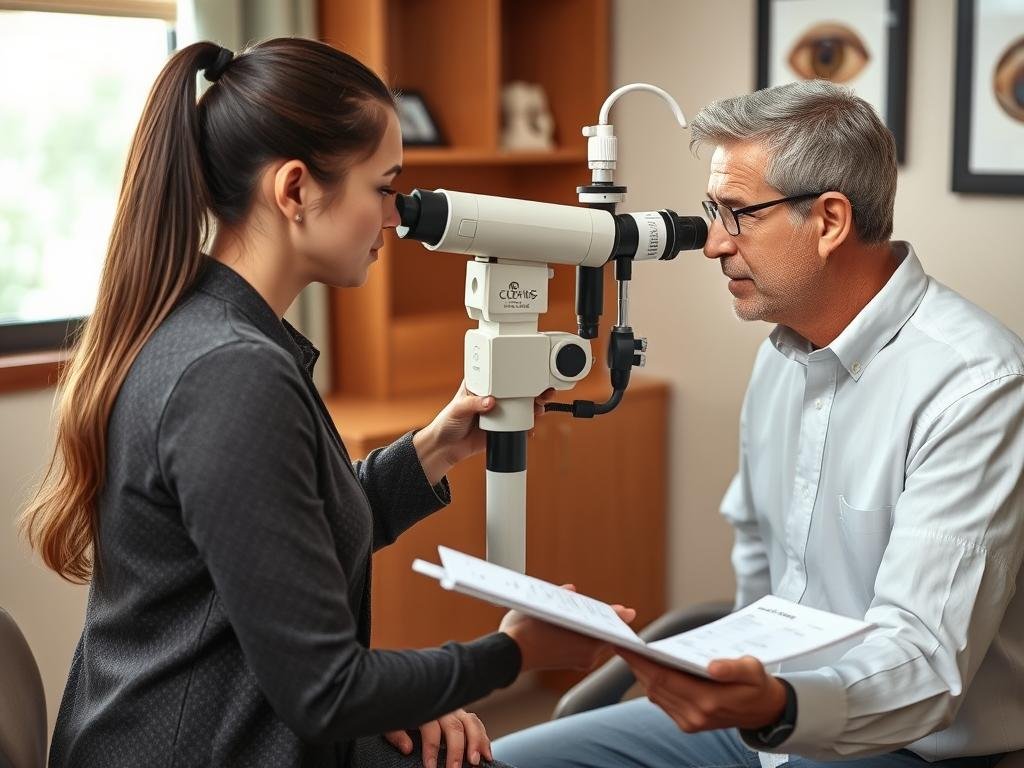The right iris in iridology chart serves as a fascinating window into your body’s health. Iridology, the study of iris patterns and colors, suggests that the right eye specifically reflects the condition of organs on the right side of your body. While conventional medicine remains skeptical, many holistic practitioners use these intricate maps to identify potential health imbalances before symptoms appear. This comprehensive guide explores how iridologists interpret the right iris, what each zone represents, and how these patterns might offer insights into your overall wellbeing.
Understanding Iridology and the Right Iris Connection


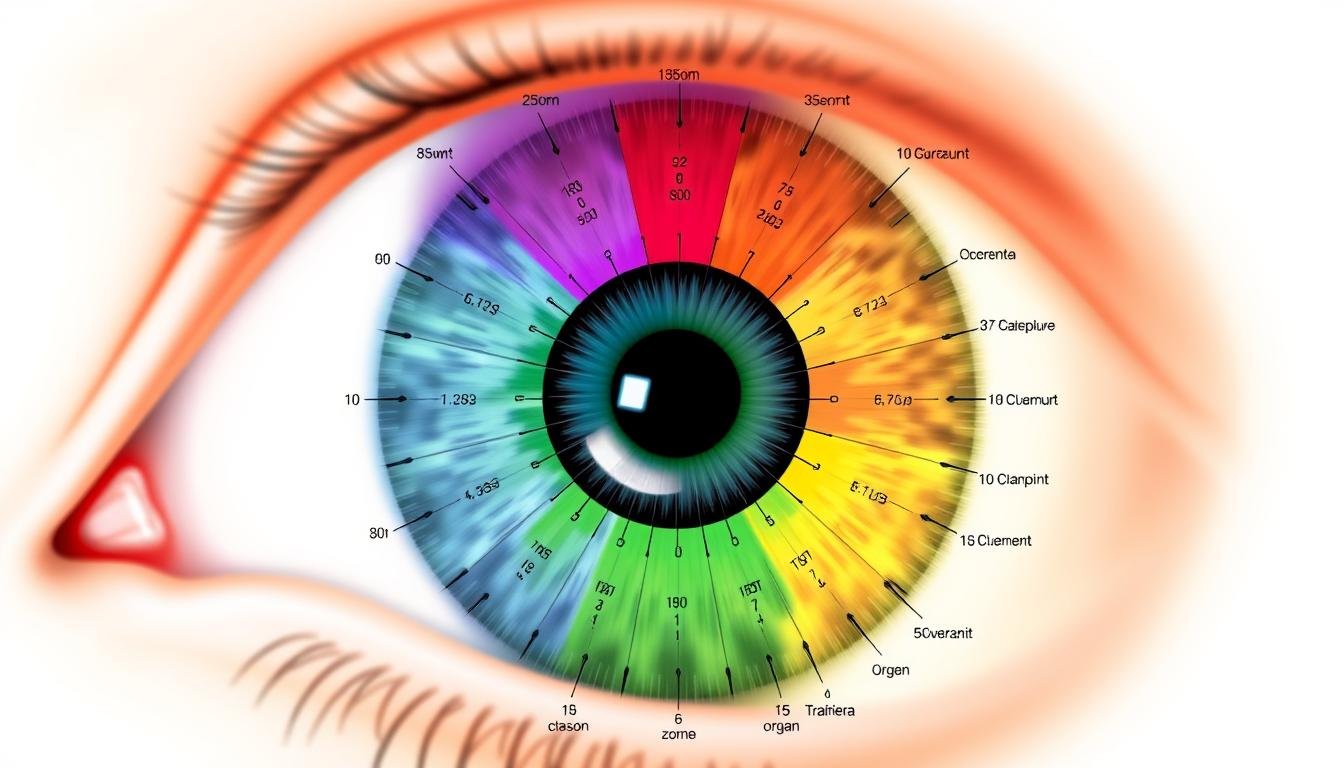
Detailed iridology chart showing how the right iris is mapped to various body systems
Iridology is the study of the ирис, the colored part of your eye, to assess potential health conditions. Practitioners believe that different zones of the iris correspond to various organs and systems in the body. The right iris specifically reflects the organs and systems on the right side of your body, while the left iris corresponds to the left side.
The Science Behind Right Iris Analysis
The iris contains thousands of nerve endings connected to the brain via the optic nerve. Iridologists believe these connections create a “карта” where changes in body tissues are reflected in iris fibers. The right iris is particularly associated with the liver, gallbladder, and right kidney – organs predominantly located on the right side of the body.
Historical Development of Right Iris Mapping
The specific mapping of the right iris dates back to the work of Dr. Ignatz von Peczely in the 1800s. After noticing changes in an owl’s iris after it suffered a broken leg, he developed the first iridology chart. Later practitioners refined these maps, creating more detailed connections between specific iris zones and body systems.
Right vs. Left Iris: Key Differences
Understanding the distinction between right and left iris interpretation is fundamental in iridology. While both irises provide health insights, they reflect different bodily systems.
| Body System |
Right Iris Association |
Left Iris Association |
| Digestive Organs |
Liver, Gallbladder, Ascending Colon |
Stomach, Spleen, Descending Colon |
| Filtering Systems |
Right Kidney, Right Adrenal |
Left Kidney, Left Adrenal |
| Lymphatic System |
Right Lymphatic Channels |
Left Lymphatic Channels, Spleen |
| Reproductive System |
Right Ovary/Testicle |
Left Ovary/Testicle, Uterus |
| Brain Function |
Logical Processing, Analytical Thinking |
Creative Processing, Emotional Centers |
Mapping the Zones of the Right Iris in Iridology Chart

Concentric zones in the right iris mapped to different body systems
The right iris in iridology chart divides the eye into concentric zones, radiating from the pupil outward. Each zone corresponds to different organs and systems, with the innermost zones representing the digestive system and the outermost zones reflecting the skin, lymphatic system, and extremities.
Central Zone: Digestive System Mapping
The area immediately surrounding the pupil in the right iris relates to the digestive system. Iridologists pay particular attention to this zone when examining digestive health. Markings here may indicate issues with:
- Stomach acid production and balance
- Intestinal flora and gut health
- Nutrient absorption capabilities
- Digestive enzyme activity
Middle Zone: Circulatory and Filtering Systems
Moving outward from the pupil, the middle zone of the right iris corresponds to major filtering and circulatory organs, particularly those on the right side of the body. This includes:
- Liver function and detoxification capacity
- Gallbladder health and bile production
- Right kidney filtration efficiency
- Lymphatic drainage on the right side
Outer Zone: Skin, Muscles, and Extremities
The outermost zone of the right iris relates to the body’s exterior systems and extremities on the right side. Iridologists examine this area for indications about:
- Skin conditions and detoxification ability
- Muscular tension and inflammation
- Joint health and mobility issues
- Circulation to extremities
Discover Your Personal Iris Analysis
Curious about what your right iris reveals about your health? Our certified iridologists can provide a detailed analysis of your iris patterns and what they might indicate about your body’s systems.
Book Your Iris Analysis
Specific Organ Representations in the Right Iris
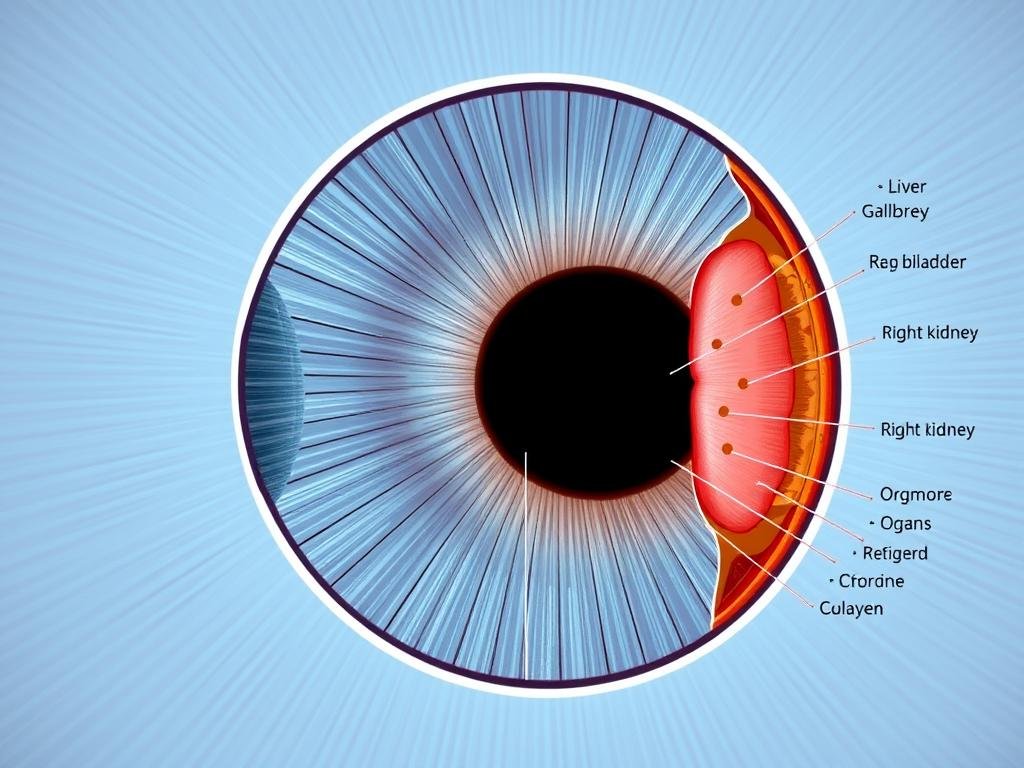
Organ-specific mapping in the right iris according to iridology
Beyond the general zones, iridology charts divide the right iris into specific sections that correspond to individual organs. These precise mappings allow practitioners to focus on particular body systems when analyzing iris patterns.
Liver and Gallbladder Representation
The liver and gallbladder hold prominent positions in right iris analysis, typically appearing between the 7 and 9 o’clock positions when viewing the right iris. Iridologists look for:
- Brown spots that may indicate liver toxicity
- Yellow discoloration suggesting possible gallbladder inflammation
- White fibers potentially indicating scar tissue or stress in these organs
- Dark markings that might reflect long-term liver congestion
Right Kidney and Adrenal Mapping
The right kidney and adrenal gland typically appear in the lower quadrant of the right iris. When examining this area, iridologists note:
- Dark lesions that may suggest kidney stress
- White fibers potentially indicating adrenal fatigue
- Lacunae (pit-like formations) that might reflect chronic kidney issues
- Color changes suggesting filtration challenges
Respiratory System Indicators
The right lung and bronchial passages are mapped to specific areas in the right iris, usually in the upper quadrants. Practitioners examine:
- Whitish clouds that may indicate mucus accumulation
- Dark markings potentially suggesting chronic respiratory issues
- Radial lines that might reflect bronchial sensitivity
- Color changes in these zones suggesting oxygenation challenges
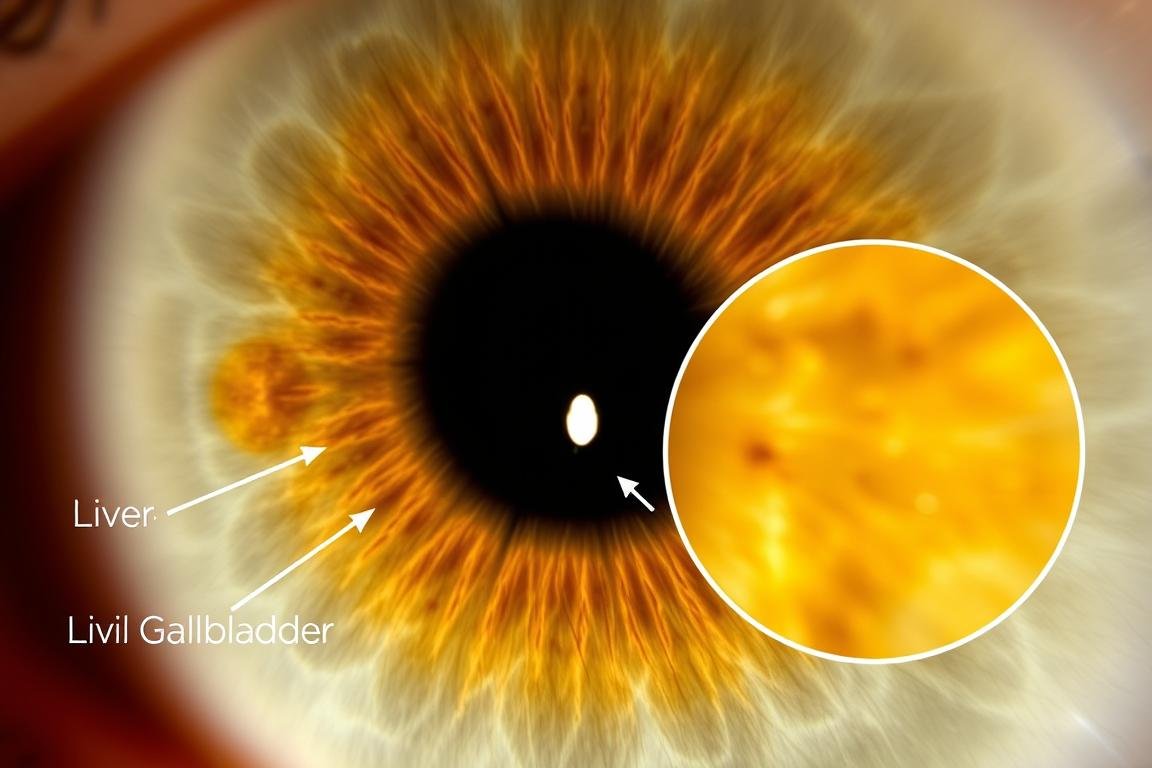
Close-up view of liver and gallbladder zones in the right iris with typical markings
Interpreting Signs and Markings in the Right Iris
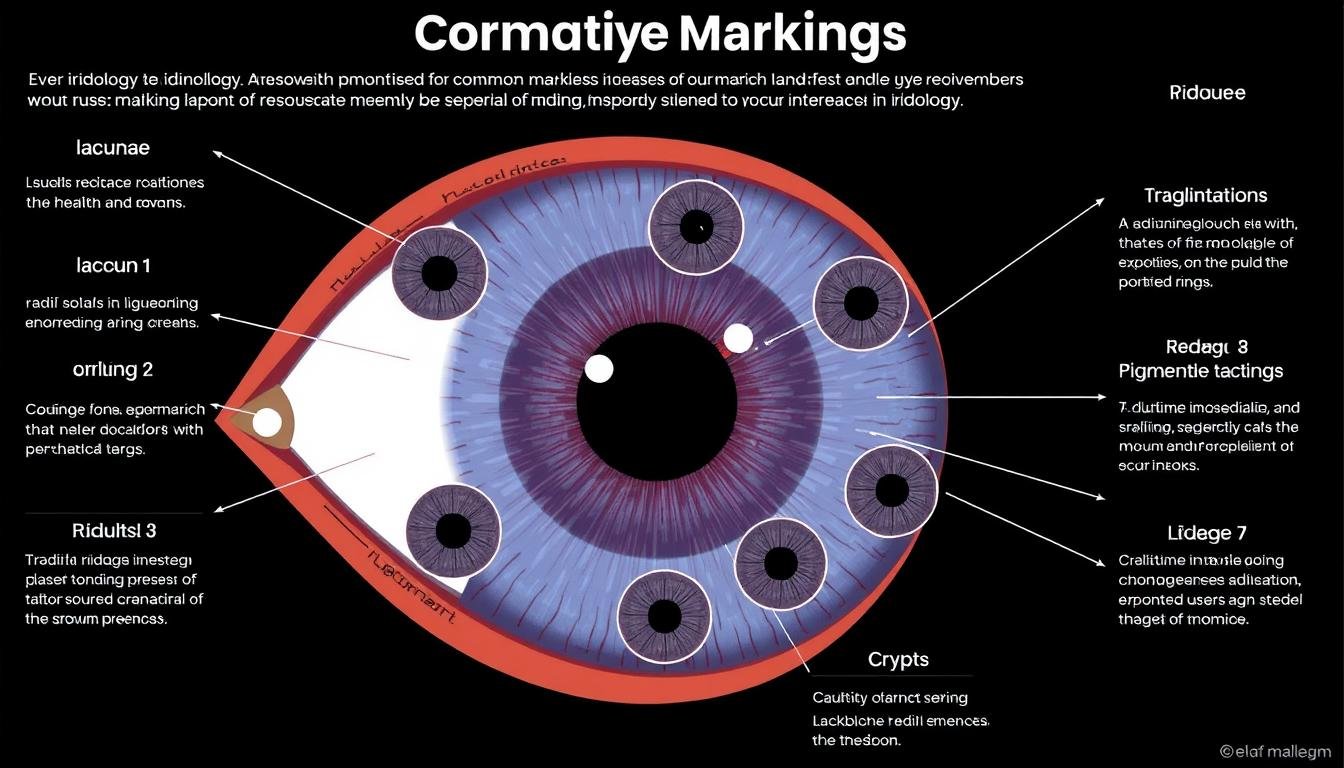
Common iris markings and their interpretations in iridology
Iridologists analyze various markings, colors, and patterns in the right iris to assess health status. These signs form the foundation of iridology interpretation and provide insights into potential health imbalances.
Color Variations and Their Meanings
The base color of the iris provides fundamental information about constitutional strengths and tendencies. In right iris analysis:
- Blue iris: Often indicates a lymphatic constitution with potential sensitivity in the respiratory and digestive systems
- Brown iris: Typically suggests a hematogenic constitution with stronger liver function but potential sensitivity to blood sugar imbalances
- Mixed/hazel iris: May reflect a biliary constitution with particular focus on liver and gallbladder function
- Color transitions: Areas where color changes within the iris might indicate adaptive changes in tissue function
Structural Signs: Lacunae, Crypts, and Radii Solaris
Structural markings in the iris provide specific information about tissue conditions:
- Lacunae: Enclosed, often darkened areas that may indicate inherent weakness or lesions in the corresponding organ
- Crypts: Small, well-defined openings that might reflect genetic predispositions
- Radii Solaris: Spoke-like lines radiating outward that potentially indicate toxin elimination pathways or nerve irritation
- Pigmentations: Colored spots that may suggest mineral deposits or toxin accumulation
Rings and What They Reveal
Circular formations in the iris can provide insights about systemic conditions:
- Nerve Rings: Circular lines that may indicate nervous tension or stress responses
- Lymphatic Rosary: A series of white dots forming a circle that potentially suggests lymphatic congestion
- Scurf Rim: Darkening at the outer edge of the iris that might indicate skin elimination challenges
- Contraction Rings: Circular spasms in the iris fibers that may reflect tension in the corresponding organs
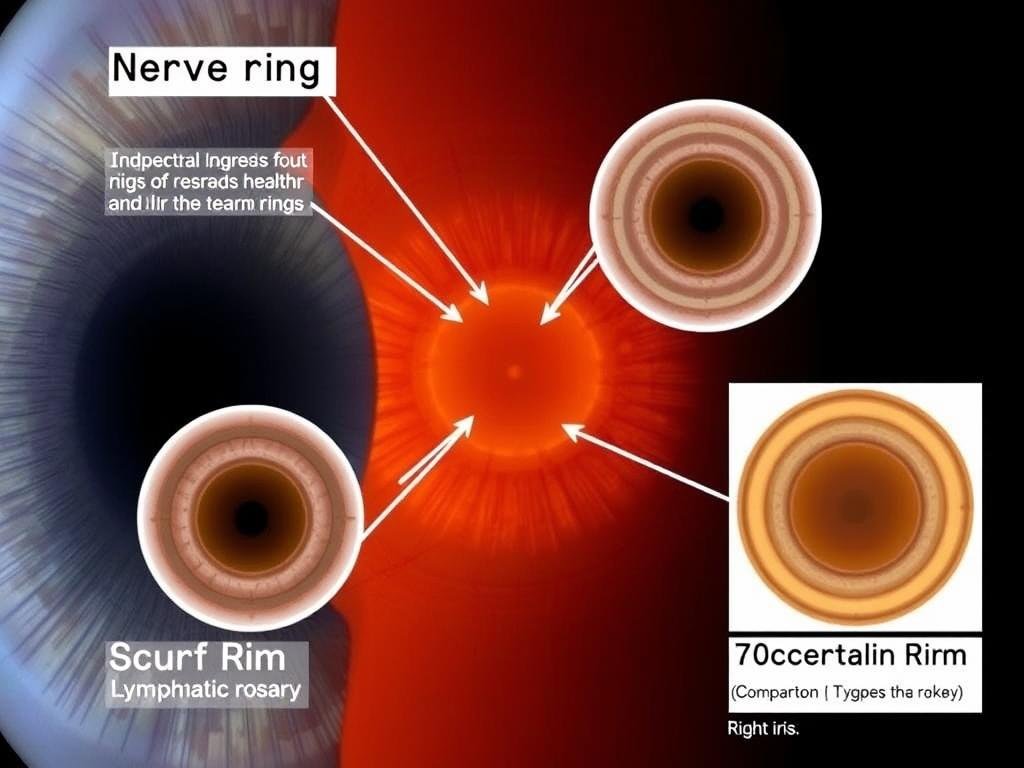
Different types of rings observed in right iris analysis and their potential health implications
Case Studies: Right Iris Analysis in Practice
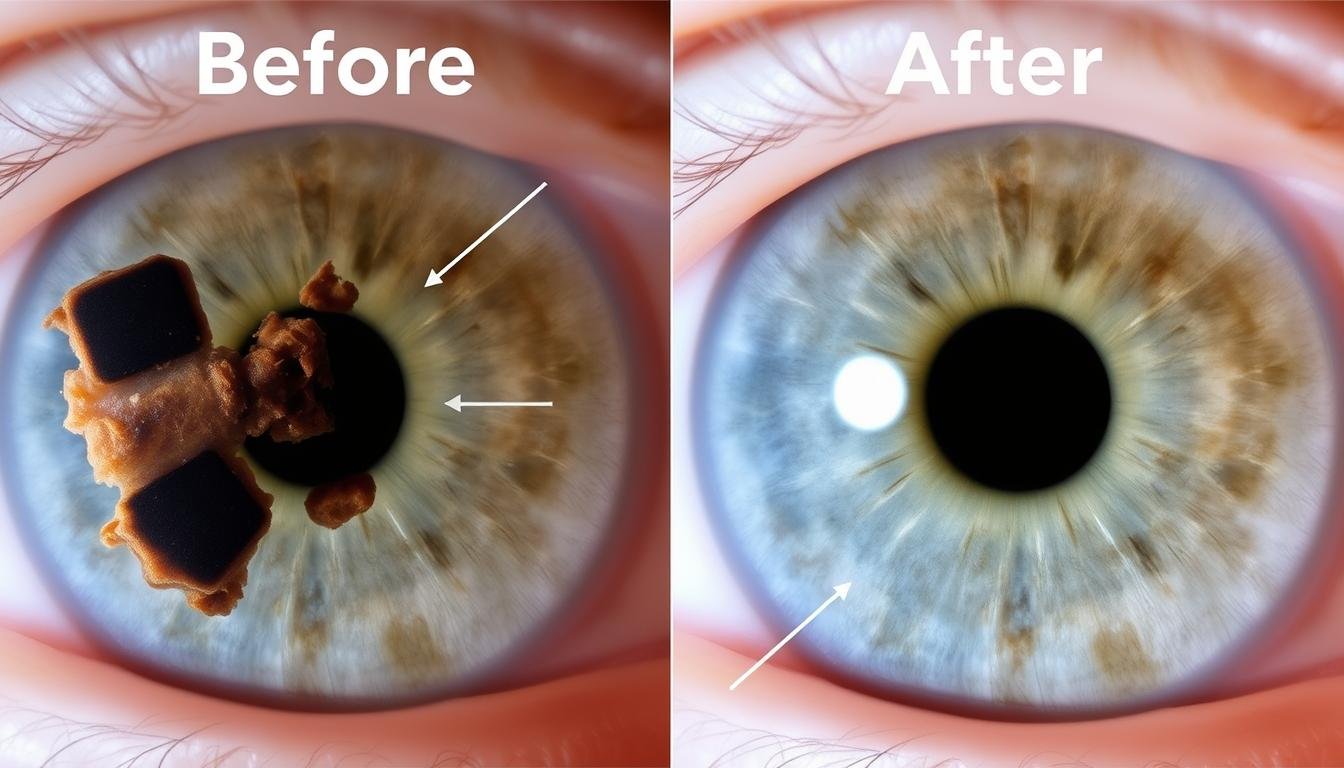
Before and after images of a right iris showing changes following health interventions
Examining real-world examples helps illustrate how iridologists apply right iris in iridology chart analysis to identify potential health concerns and track improvements over time.
Case Study 1: Liver Function Improvement
A 42-year-old male presented with fatigue, digestive discomfort, and skin issues. Initial right iris analysis showed:
- Brown pigmentation in the liver zone (7-8 o’clock position)
- Yellowish discoloration in the gallbladder area
- Multiple radii solaris extending from these areas
After three months of dietary changes, herbal support, and detoxification protocols, follow-up iris analysis revealed:
- Reduced brown pigmentation in the liver zone
- Decreased yellowish tint in the gallbladder area
- Fewer and less pronounced radii solaris
These changes correlated with improved energy levels, better digestion, and clearer skin.
Case Study 2: Respiratory System Recovery
A 35-year-old female with chronic bronchial issues showed these initial right iris signs:
- White cloudy areas in the lung zone (2-3 o’clock position)
- Several small lacunae in the bronchial region
- Lymphatic rosary pattern visible around the iris
Following six months of respiratory support, immune-enhancing protocols, and environmental changes:
- White cloudy areas showed significant clearing
- Lacunae appeared less pronounced and lighter in color
- Lymphatic rosary pattern had diminished considerably
These iris changes corresponded with reduced bronchial symptoms, improved breathing capacity, and fewer respiratory infections.
Tracking Progress Through Iris Changes
These case studies demonstrate how iridologists use sequential right iris analysis to:
- Document baseline conditions before interventions
- Track subtle changes that may precede symptomatic improvement
- Assess the effectiveness of health protocols
- Provide visual feedback to motivate continued health practices
Document Your Iris Health Journey
Would you like to track changes in your iris patterns over time? Our professional iris photography and analysis service provides baseline documentation and follow-up comparisons to visualize your health progress.
Learn About Iris Tracking
Practical Applications of Right Iris Analysis
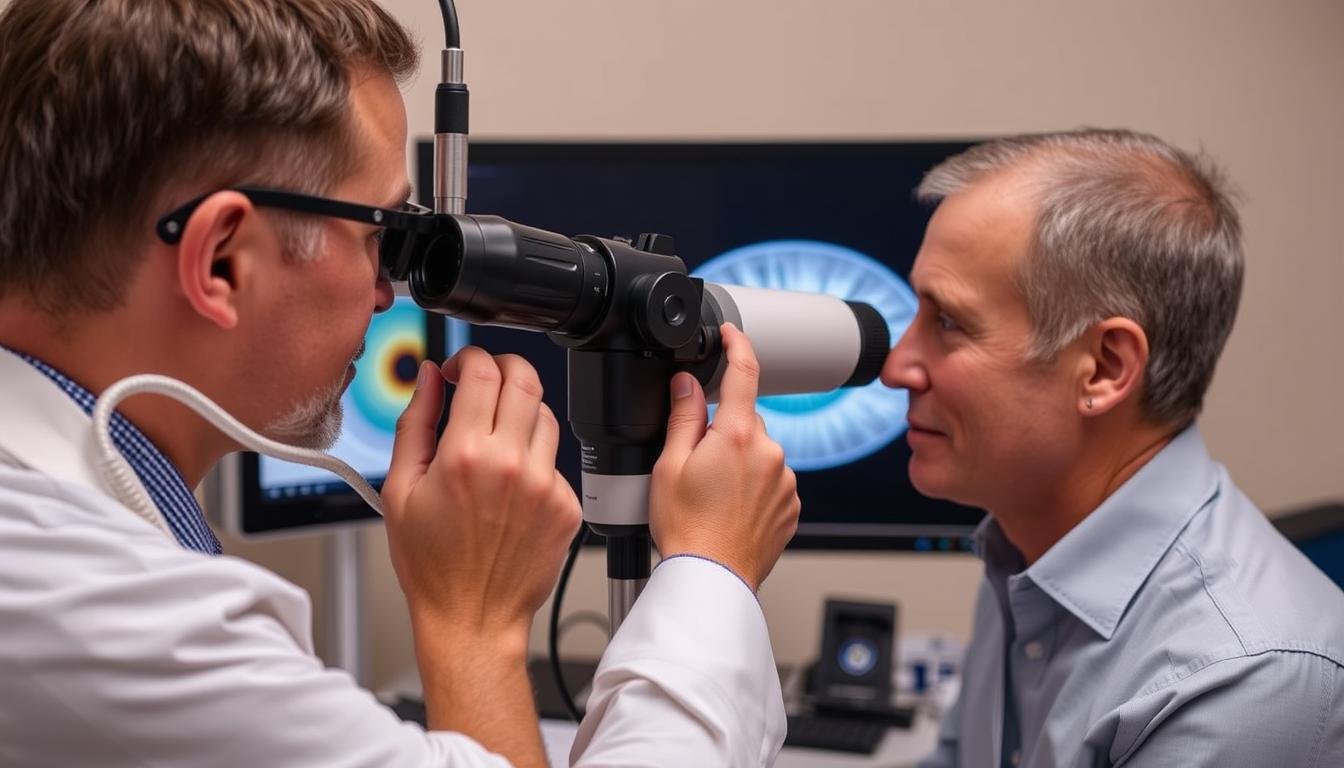
Professional iridology analysis being performed with specialized equipment
Beyond theoretical understanding, right iris analysis has several practical applications in holistic health assessment. Here’s how practitioners and individuals can apply this knowledge.
Self-Assessment Basics for Right Iris
While professional analysis is ideal, you can perform basic self-observation of your right iris:
- Use a well-lit magnifying mirror in natural daylight
- Note the overall color, clarity, and fiber patterns
- Look for obvious markings, discolorations, or rings
- Compare observations over time to track changes
- Document with clear photographs if possible
Complementary Health Approaches
Right iris analysis often works synergistically with other holistic health practices:
- Nutritional therapy targeted to specific organ systems identified in iris analysis
- Herbal protocols selected based on constitutional iris type
- Detoxification programs focused on elimination pathways shown in the iris
- Stress management techniques addressing nervous system patterns visible in iris rings
When to Seek Professional Iris Analysis
Consider consulting a professional iridologist when:
- You notice significant changes in your iris patterns or colors
- You’re developing a comprehensive health optimization plan
- You have chronic health concerns without clear causes
- You want to identify potential health vulnerabilities before symptoms develop
- You’re interested in a baseline assessment for future comparison
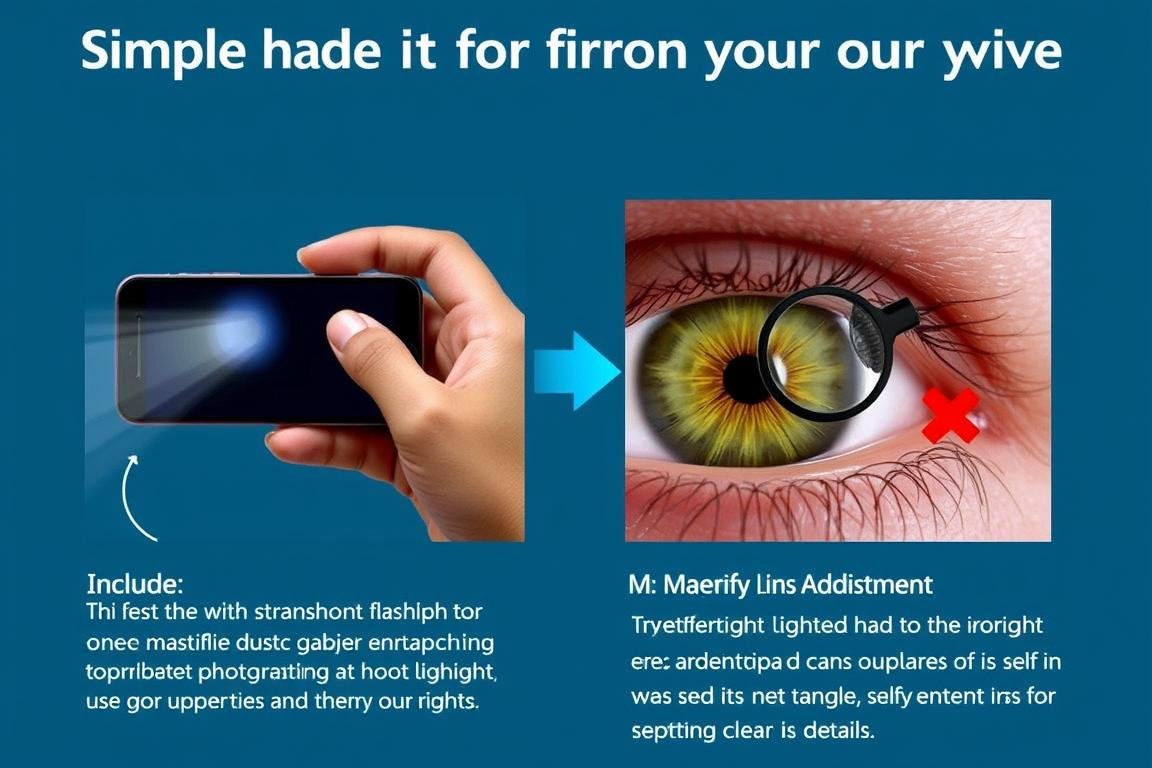
Simple home setup for photographing your iris for self-monitoring
Scientific Perspective on Right Iris Iridology Charts

Comparison between traditional iridology mapping and scientific iris anatomy
While iridology has passionate practitioners, it’s important to understand the scientific community’s perspective on iris analysis and how to balance traditional iridology with evidence-based approaches.
Research and Evidence Considerations
The scientific status of iridology remains controversial:
- Limited peer-reviewed research supports specific iris-organ correlations
- Controlled studies have shown mixed results regarding diagnostic accuracy
- Iris changes related to local eye conditions are well-documented medically
- Systematic reviews generally conclude insufficient evidence for diagnostic claims
- Research on iris nerve connections with the brain continues to evolve
Integrating Iridology with Conventional Healthcare
A balanced approach to iris analysis involves:
- Using iridology as a complementary tool, not a replacement for medical diagnosis
- Consulting with conventional healthcare providers about significant health concerns
- Viewing iris signs as potential indicators rather than definitive diagnoses
- Combining iris observations with other clinical assessments and testing
- Maintaining open communication between holistic and conventional practitioners
Future Directions in Iris Research
Emerging areas of study may bridge traditional iridology and scientific understanding:
- Digital iris analysis using artificial intelligence to identify patterns
- Studies on neurological connections between iris fibers and brain centers
- Research on iris changes in response to inflammatory markers
- Investigation of genetic factors in iris structure and health correlations
- Development of standardized protocols for iris photography and analysis
Potential Benefits of Iridology
- Неинвазивный метод оценки
- May identify tendencies before symptoms develop
- Encourages holistic health awareness
- Can motivate preventative health practices
- Provides visual feedback on health changes
Limitations to Consider
- Limited scientific validation
- Practitioner interpretation varies
- Cannot diagnose specific diseases
- Should not replace medical testing
- May lead to delayed proper treatment if used exclusively
Frequently Asked Questions About Right Iris Analysis
What can the right iris specifically reveal about my health?
According to iridology principles, the right iris particularly reflects organs and systems on the right side of your body. This includes the liver, gallbladder, right kidney, right lung, and right side of the brain. Practitioners believe patterns in your right iris can indicate potential weaknesses, inflammation, or toxin accumulation in these areas. However, it’s important to note that iridology is considered complementary to, not a replacement for, conventional medical diagnosis.
How does the right iris in iridology chart differ from the left?
In iridology, the right and left irises correspond to different sides of the body. The right iris primarily reflects organs on the right side (liver, gallbladder, right kidney, etc.), while the left iris corresponds to organs on the left (heart, stomach, spleen, left kidney, etc.). Some iridologists also associate the right iris with paternal genetic influences and the left with maternal influences. The interpretation of specific markings follows the same principles in both eyes, but their significance varies based on the corresponding body areas.
Can iris analysis detect serious health conditions?
Iridology is not designed to diagnose specific diseases or medical conditions. Rather, practitioners use it to identify areas of potential weakness, stress, or toxin accumulation in the body. While some iridologists claim to observe patterns associated with certain health tendencies, scientific evidence supporting these specific correlations is limited. Always consult with healthcare professionals for proper diagnosis of medical conditions, using iridology only as a complementary perspective.
How often should I have my iris analyzed?
For those interested in iris analysis, practitioners typically recommend an initial comprehensive assessment followed by periodic check-ups. Many suggest annual reviews for general monitoring, while those actively addressing specific health concerns might benefit from evaluations every 3-6 months to track potential changes. Significant iris changes typically occur gradually, reflecting long-term health patterns rather than acute conditions.
Can I perform basic iris analysis at home?
While professional analysis provides the most comprehensive assessment, you can perform basic self-observation at home. Use a well-lit magnifying mirror in natural daylight, and compare your iris to reference charts. You can also take clear, close-up photographs of your iris over time to track any changes. However, interpreting subtle markings and patterns requires training and experience, so consider self-analysis as preliminary observation rather than definitive assessment.
Conclusion: The Value of Right Iris Analysis in Holistic Health

Collaborative approach to health using iris analysis as one assessment tool
The right iris in iridology chart offers a fascinating window into potential health patterns, particularly for organs and systems on the right side of the body. While scientific validation remains limited, many find value in this non-invasive assessment tool as part of a comprehensive approach to wellness.
Whether you approach iridology with curiosity or conviction, its greatest benefit may lie in encouraging proactive health awareness. By observing potential patterns before symptoms develop, iris analysis can motivate positive lifestyle changes and early intervention strategies.
As with any health approach, balance is key. Consider iris analysis as one piece of your health puzzle, complementing rather than replacing conventional medical care. The most effective health journeys integrate multiple perspectives, combining the best of traditional wisdom with modern scientific understanding.
Ключевые выводы
- The right iris specifically reflects organs and systems on the right side of your body
- Iris analysis is non-invasive and can potentially identify tendencies before symptoms appear
- Different zones, colors, and markings in the iris correspond to specific body areas
- Iridology works best as a complementary tool alongside other health assessments
- Regular iris documentation can help track potential changes in health patterns over time
Begin Your Iridology Journey
Ready to explore what your eyes reveal about your health? Our experienced practitioners combine traditional iridology wisdom with modern health approaches for a comprehensive wellness assessment.
Schedule Your Consultation Today

























